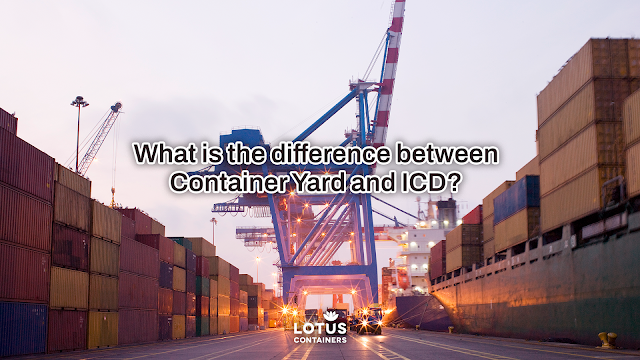What is the difference between Container Yard and ICD?
Various maritime facilities maintain the seamless functioning of supply chain operations and ensure the on-time delivery of international shipments. The maritime infrastructures, including docks, container yards, and container depots, hold their importance and have significant roles. Although all these infrastructures focus on fulfilling the same shipping such as container handling, intermodal transport, container inspection, customs clearances, maintenance and repairs, and temporary storage of freight containers, they are slightly different. Let us learn more about the difference between a container yard and an ICD (Inland Container Depot).
What is a Container Depot?
Container depots are maritime infrastructures located on the port facilities inside container terminals or in the hinterlands. Depots are temporary storage for shipping containers for transhipment, loading, unloading, maintenance, repairs, or inspection. Container depots are effectively utilized for intermodal transportation to facilitate logistics activities. Depots can vary according to their sizes based on the popularity and usage of the shipping port. They can be private or government-owned depots and, therefore, differ in their facilities. While many depots can specialize in container handling through appropriate equipment, others handle standard shipments. Ports located near major transportation hubs handle all types of cargo to facilitate international and commercial shipping.
What is ICD in shipping?
An inland container depot is a type of container depot situated in the hinterlands near the major transportation hub and connected to a vast network of roads and rails. It serves as a site for intermodal transportation for shipping containers. Since it is located away from the coastline, it is also known as a dry port. Inland depots are capable of handling loaded and empty shipping containers. It is also a similar facility to the container freight station (CFS), which is an off-dock facility and is not necessarily located inland. ICD handles the containerization of break-bulk cargo and connects the port and other modes of transport, such as roads and rails. They are responsible for managing customs clearances, decongesting shipping ports, cargo consolidation, and maintenance of freight containers.
What is a container yard?
It is also known as a container terminal or freight station located within the port infrastructure. Terminals are gateways from one country to the other. All the inbound shipping containers meant for transhipment are brought to the container yard and are then stored, organized, and processed to be made ready for further intermodal transportation. The logistics facility specializes in handling and temporarily storing containers until time arrives. Container yards or terminals often have an administrative or customs office on the premises to facilitate immediate container inspection and supervise cargo loading and unloading. The documentation for various import and export trade businesses is carried out at the terminal facility. They can vary in size depending on the type of port they are located in, regional or major.
Difference between Container Yard and ICD
Location- Inland container depots are away from the coastline and the seaport. They are generally closer to transportation hubs such as railway lines or highways. Container yards or terminals are port facilities near the dock or berths where shipping containers are loaded or unloaded from vessels.
Role- ICDs are transhipment hubs for inland cargo handling, cargo consolidation, container maintenance and repairs, and customs clearances. The container yard is a platform for moving shipping containers inside the port and connects sea and land transport. It is designed for handling all types of shipping containers.
Customs clearances- ICD offers customs clearances and documentation in collaboration with the port authorities while container yards have a customs department on the premises to look into documentation and clearances, while
Maintenance and repairs- The temporary storage time of shipping containers is longer at ICDs than at container terminals. Therefore, more comprehensive maintenance and repair can be done at depots compared to terminals.
Intermodal connectivity- ICDs are located on the hinterlands and are, in most cases, directly connected to the railways and welcome shipping containers inbound from highways. Container yards are located inside the mother port and are not directly connected to the rail network. Transport via road is the only way of linking sea to rail.
Although both are port facilities, the difference between Container Yard and ICD clarifies the concept of both maritime infrastructures.
LOTUS Containers, a marketer of shipping container services, offers buying and leasing shipping containers.



Comments